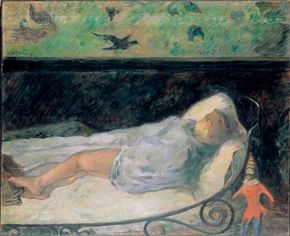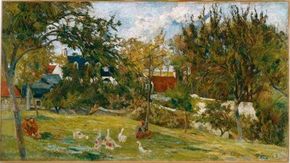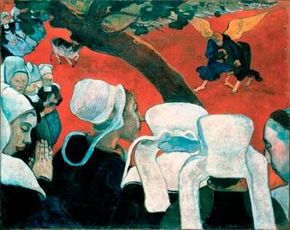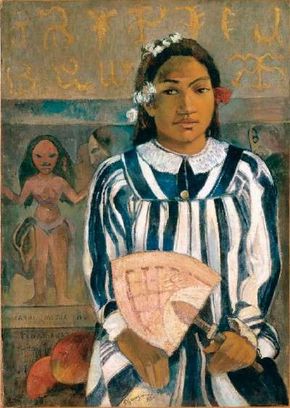When Paul Gauguin submitted his work to be considered for the Impressionists' fourth exhibition, not many had heard of the stock agent who had only recently taken up painting. Despite the fact the works had been submitted after the official deadline, the organizers of the event were convinced by his talent and decided to show it anyway. Critical response was positive, and Gauguin joined the Impressionist fold.
By the eighth Impressionist exhibition, however, critical assessment of Paul Gauguin's work had turned sour. In reviews of the final exhibition, critics dismissed his work as classic Impressionism, and in reaction, Gauguin chose imagination and memory as central forces in his art.
Advertisement
Leaving Paris behind, Paul Gauguin briefly joined Vincent van Gogh in Arles, but Gauguin had already moved far from his association with the Impressionists. Always charismatic, Gauguin attracted a circle of young artists, including Paul Sérusier, who took inspiration from Gauguin's brilliance, and they led the vanguard of the next generation of French artists.
Below are some links to famous paintings by Paul Gauguin. Follow them to learn more about the Impressionist master who was once a stock agent.
- The Market Gardens of Vaugirard: The Market Gardens of Vaugirard by Paul Gauguin shows Gauguin painting in the tradition of fellow Impressionist Camille Pissarro. Learn about Gauguin's The Market Gardens of Vaugirard.
- The Little One is Dreaming, Etude: One of Gauguin's young children is the subject for his 1881 work The Little One is Dreaming, Etude. Read about Gauguin's The Little One is Dreaming, Etude, notable for its intimacy.
- Paysage à Saint-Cloud: Paysage à Saint-Cloud by Paul Gauguin was part of the Impressionists eighth exhibition, and was dismissed by the critics. Read about Gauguin's Paysage à Saint-Cloud.
- Vision After the Sermon: Paul Gauguin's Vision After the Sermon is seen by critics as Gauguin's rejection of Naturalism. Learn about Vision After the Sermon, by Paul Gauguin, which marked a new direction for the artist.
- Tehamana Has Many Ancestors (Merahi metua no Tehamana): Tehamana Has Many Ancestors by Paul Gauguin is one of a number of works that emerged from Gauguin's trips to Tahiti. Learn about Tehamana Has Many Ancestors by Paul Gauguin, a portrait of Gauguin's longtime Tahitian companion.
On the next page, you'll find a detailed look at Gauguin's painting The Market Gardens of Vaugirard.
For more on Impressionist paintings, artists, and art history, see:
For more on Impressionist paintings, artists, and art history, see:
Advertisement




